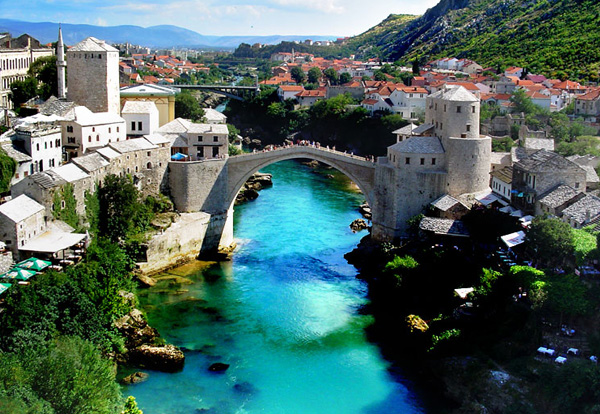 |
 |

Mostar is located in the center of Herzegovina. The city has beautiful architecture from the Ottoman and Austro-Hungarian periods. The city's construction began in the Middle Ages and its development sharply increased with the arrival of the Ottomans, particularly in the 16th and 17th c.s, during which time the stone bridge over the Neretva River, today known as the Old Bridge, was built. This is one of the 10 most famous bridges in the world (www.touropia.com).
Mostar is the ideal location to find accommodation and can be used as a launching point for excursions to other destinations in Herzegovina, all of which are no more than an hour away by car.
The symbol of the city of Mostar is, without doubt, the Old Bridge, (bs. Stari most), which was constructed between 1557 and 1566. The bridge was built to replace the medieval wooden chain bridge upon the orders of Sultan Suleiman the Magnificent at the request of the residents of Mostar. Mimar Hajruddin, a student of the most famous Ottoman architect Mimar Sinan, was the bridge's architect. Hajji Mehmed-beg Karađoz supervised the bridge's construction and was also responsible for building the Karađoz-beg Mosque in Mostar. Mostar's Old Bridge has an arch almost 29 m in length and 20 m in height. Throughout history, the bridge has frequently changed names, and has been referred to as "New," "Sultan Suleiman," "Big," and is today known as "Old." The towers next to the bridge, Tara and Herceguša on the left bank, and Halebija on the right bank, were built in the 15th c. and have been reconstructed on several occasions. In the Tara Tower you'll find the Old Bridge Museum, while the Halebija Tower houses a gallery with historical pictures of Mostar. The bridge was destroyed on 9.11.1993. Since the completion of an authentic reconstruction in 2004, it has been included on the UNESCO list of world heritage sites.
During your visit to Mostar, make sure to see a traditional jump from the Old Bridge into the Neretva River. Depending on the level of water in the river, jumps are taken at heights between 23 and 27 m. At the end of July, there's a traditional competition of jumpers from the Old Bridge. In 2013, the 447th competition was held. Contestants compete in two categories - those who jump head first, and those who jump feet-first.
Over time, the area around the Old Bridge evolved into the economic center of Mostar. The area on the left bank was named Kujundžiluk after the many artisans here who make and sell copper handicrafts. During the Ottoman period, this was a commercial center for the entire region, with over 500 stores. Craftsmen were organized into 30 craft associations or guilds. Each guild had its own street, which was named for the trade practiced there. Today, this part of the city has retained its authentic look, with numerous craft shops and traditional restaurants. Traditional crafts are still kept alive by a number of artists. The most famous include: Ramiz and Edin Pandur (copper), Ismet Kurt (copper) and Mustafa Šoše (embroidery). Their shops are worth a visit.
....
While in Mostar, it's worth visiting three national monuments dating from the Ottoman period: the Muslibegović House (18th c.), the Bišćević House (17th c.) and the Kajtaz House (18th c.). A tour of these three complexes will acquaint you with the rich residential culture of wealthy families in Herzegovina during that time. Each house consisted of a service area (selamluk), an area for the family (haremluk), and a yard. In the service area, servants were housed and storage areas for goods could be found. It was possible to enter this part of the house whether one was invited or not. In the family area, the residential rooms, kitchen, and bathroom could be found.
The Muslibegović House (bs. kuća) is probably the most architecturally impressive residential building in Herzegovina. It was the first four-story building to be built. The house is characterized by a central hall, for better use of space, a double-arched main entrance with stairs, and a porch overlooking the courtyard. The building has retained its authentic form, woodwork, and original objects and artifacts. Today, the ground floor is a hotel (one of the top 10 according to the Expedia Insiders Select 2010 list ), while the upper floors house a museum.
....
The text of this subchapter can be found in the book.
The text of this subchapter can be found in the book.